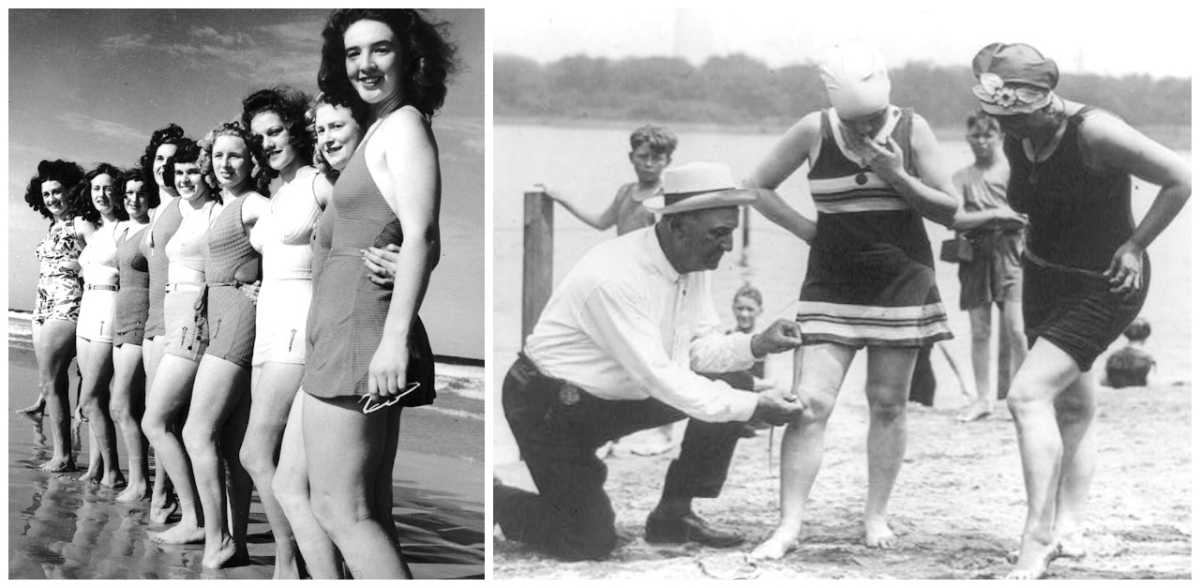From Wool to Freedom: A Splash Through 1920s Swimwear
Hey there, bathing suit enthusiasts and history buffs! Get ready to dive into the fascinating world of 1920s swimwear. We’re about to uncover the surprising history of these iconic garments—from their humble beginnings as modest wool garments to their transformation into symbols of freedom and fashion. Get ready to explore the controversies, cultural influences, and technological innovations that made waves in the unforgettable decade of the Roaring Twenties!
What Were 1920s Bathing Suits Like?
The 1920s were a time of immense social change, and swimwear certainly rode the wave! Early in the decade, you’d still see echoes of Victorian sensibilities—high necklines, longer hemlines, often made from (gasp!) wool. Imagine swimming in that!
But as the Roaring Twenties truly roared, new fabrics like stretchy, ribbed jersey changed the game. Swimsuits could now hug the body more closely, leading to designs that would have been considered scandalous just a few years earlier. Hemlines crept up, necklines plunged, and suddenly, showing a bit of skin wasn’t so taboo.
This shift to skimpier suits wasn’t just about fashion; it reflected changing attitudes towards women, leisure, and self-expression.
The Rise of the Two-Piece
One of the biggest splashes was the introduction of the “two-piece” suit by Jantzen in 1921. Now, before you picture the bikinis of today, this “two-piece” still had shorts that came up to the waist. But compared to what came before, it was revolutionary! It allowed for more freedom of movement and a chance to catch some rays, which became increasingly popular as beach-going became a national pastime.
Controversy and Change
Of course, not everyone was thrilled with these daring new swimsuits. Some, especially from more conservative circles, voiced their disapproval, even attempting to enforce stricter dress codes at beaches. But the tide was turning. These skimpier swimsuits weren’t just garments; they became symbols of the newfound freedom and self-expression that women were embracing in the 1920s, a trend that would continue to shape fashion for decades to come.
Navigating Modesty: Bathing Suit Laws of the 1920s
The Roaring Twenties weren’t just about flappers and jazz; bathing suits were undergoing their own revolution! While today’s swimsuits might seem tame in comparison, back then, even showing a bit of ankle was considered quite daring. Believe it or not, strict regulations dictated what people could and couldn’t wear at the beach.
The Early 1900s: A Sea of Modesty
In the early 1900s, swimwear was all about modesty. Women were expected to wear what essentially looked like long dresses made from heavy fabrics like wool. High necklines, long sleeves, and even stockings were the norm. Men weren’t off the hook either; going shirtless was often a no-no.
The Annette Kellerman Incident
Change, however, was on the horizon. In 1907, Australian swimmer and actress Annette Kellerman caused a sensation when she donned a form-fitting one-piece swimsuit inspired by men’s styles. She was promptly arrested for indecent exposure, highlighting just how strict those bathing suit laws really were. Kellerman’s defiance sparked a debate that would continue throughout the decade.
The Six-Inch Rule and Other Regulations
Around this time, new, lighter fabrics like latex and nylon were being developed. This was a game-changer for swimwear. Suddenly, designers could create suits that were more body-hugging and less bulky. Hemlines started to creep up, sleeves vanished, and necklines plunged lower, revealing more of the chest and back.
These changes didn’t go unnoticed. Cities across the US grappled with how to handle this newfound “immodesty.” Washington D.C., for instance, came up with the “six-inch rule.” This rule dictated that a woman’s swimsuit hemline couldn’t be more than six inches above her knee. Imagine police officers patrolling beaches with rulers, measuring bathing suits! Well, it happened! Violators faced fines, forced outfit changes, or even jail time.
Beyond Fabric and Hemlines
The bathing suit debates of the 1920s went far beyond mere fabric and hemlines. They reflected a society grappling with evolving gender roles and anxieties about morality in a rapidly changing world. The focus on measuring women’s bodies and dictating their attire had a significant impact on perceptions of beauty and body image—issues that still resonate today.
While the “six-inch rule” and other such regulations are long gone, the bathing suit’s journey serves as a reminder of how cultural norms and fashion choices are often intertwined. It’s a fascinating glimpse into a time when something as simple as a swimsuit could spark national debate.
The Material Evolution: What Were 1940s Swimsuits Made Of?
The 1940s saw yet another shift in swimwear as new fabrics and a desire for both practicality and style took center stage. Imagine trading in your itchy wool swimsuit for something a little more comfy—that’s what was happening!
Rayon Rules the Beach
One fabric that totally took over was rayon. Think of it as the budget-friendly alternative to silk. Because it was cheaper and draped well, it became a hit for mass-produced swimsuits. Designers even started mixing it with jersey for extra stretch and comfort. Rayon was all about looking good and feeling good to wear.
Jersey Joins the Party
Speaking of jersey, this knitted fabric was a game-changer with its natural elasticity! Swimsuits could now fit snugly without being too revealing. And the best part? No more wrinkles! The rayon-jersey combo quickly became a favorite for its versatility.
Lastex: The Game-Changer
Hold on, things were about to get even more interesting with a little something called Lastex. Picture rubber yarn, but with superpowers! This 1930s invention was like magic for swimsuits. It gave them stretch, control, and shaping abilities that no one had seen before. Suddenly, swimsuits could hug curves in all the right ways. Designers strategically placed Lastex panels around the stomach for a slimming effect and used it in bra cups for added support and shape. Talk about a confidence booster!
Adding a Touch of Luxury
It wasn’t all just about practicality, though. Designers in the 40s also had a flair for the dramatic, adding touches of luxury to their creations. Rayon velour, a fabric as smooth as velvet, became their go-to for adding a touch of elegance. They also used a technique called ruching, where they’d gather fabric (usually rayon or jersey) to create flattering and stylish accents.
The 1940s were a time of innovation and change in swimwear. New fabrics like rayon, jersey, and Lastex made swimsuits more comfortable, stylish, and functional than ever before. But remember, our understanding of the past is always evolving as new research and discoveries emerge. So, the next time you slip into your modern swimsuit, take a moment to appreciate the fascinating journey of swimwear and the fabrics that made it all possible!
Sun-Kissed Style: What did Swimsuits Look Like in 1930?
The 1930s: This is where things start to get really interesting. Remember how 1920s swimsuits were still relatively modest? Well, the 1930s said, “Hold my beach umbrella,” and decided to shake things up!
The world was changing, women were gaining more independence, and they wanted their clothes—even their swimsuits—to reflect that newfound freedom.
Early 1930s: Baby Steps Towards Boldness
At the start of the decade, swimsuits were like the shy kid at the pool party—still clinging to the familiar styles of the 1920s with their tank-top-style tops and sewn-in shorts. But there were hints of change in the air. Backlines dipped a little lower (scandalous!), and stripes started to make a splash. It was like dipping a toe into the waters of a bolder fashion era.
Mid-1930s: Hello Sunshine, Goodbye Fabric!
By the mid-1930s, swimsuits were like, “Okay, we’re done being shy!” They were ready to make a statement. Leg lines crept higher, backlines plunged even lower, and straps got thinner, putting those shoulders on full display. It was all about showing off those curves and embracing a more athletic silhouette.
Three main styles dominated the scene:
- Skirted Suits: These added a touch of playfulness with a little skirt attached to the bottom.
- Skirtless Suits: These ditched the skirt altogether and embraced a more streamlined look.
- Dressmaker Suits: These boasted extra detailing and tailoring that wouldn’t have looked out of place at a garden party (if garden parties happened poolside).
Late 1930s: Lastex—The Fabric That Changed the Game
Remember the name “Lastex” because this fabric was a total game-changer. This revolutionary rubber-based yarn, invented in 1931, changed the swimwear world forever.
With Lastex, swimsuits could be more fitted, more flattering, and even more daring in their designs. Plus, it opened up a whole new world of colors and patterns! Think vibrant florals, bold stripes, and eye-catching geometric designs. Swimwear became a way to express your personality and stand out from the crowd.
More Than Just Fabric: The Cultural Wave
The evolution of swimsuits in the 1930s wasn’t just about fashion—it was a reflection of a changing world. Women were breaking free from old traditions and demanding to be seen and heard. Their swimsuits became a symbol of this newfound independence and a celebration of the female form.
It wasn’t always easy. Some people weren’t ready for such a dramatic shift in style. But the 1930s swimwear revolution was about more than just fabric and hemlines; it was about challenging expectations and embracing a more liberated way of life.
- Senior at What Age: Benefits & Eligibility Guide - March 29, 2025
- Unlocking Senior Benefits: How Old is a Senior? Your Complete Guide - March 29, 2025
- Master Russian Politeness:A Guide to Saying Please - March 29, 2025






![A Stitch in Time: Exploring the Evolution of Clothing in India Through the Millennia [clothing in india history] clothing-in-india-history_2](https://www.lolaapp.com/wp-content/uploads/2023/12/clothing-in-india-history_2-150x150.jpg)









